

Is Polymer.js Ready for Prime Time? A year ago, almost to the day, Google launched Polymer.js.
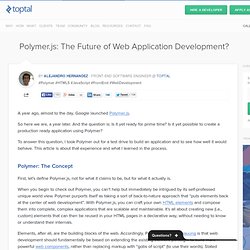
So here we are, a year later. And the question is: Is it yet ready for prime time? Is it yet possible to create a production ready application using Polymer? To answer this question, I took Polymer out for a test drive to build an application and to see how well it would behave. This article is about that experience and what I learned in the process. Polymer: The Concept First, let’s define Polymer.js, not for what it claims to be, but for what it actually is. When you begin to check out Polymer, you can’t help but immediately be intrigued by its self-professed unique world view. Elements, after all, are the building blocks of the web. OK, so that’s the theory. Polymer: The Reality While Polymer’s philosophical approach certainly has merit, it is unfortunately an idea that (at least to some extent) is ahead of its time. OK, fine. The Jackal of Javascript. This blog post is about Web Components.
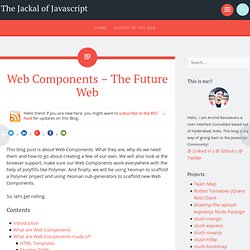
What they are, why do we need them and how to go about creating a few of our own. We will also look at the browser support, make sure our Web Components work everywhere with the help of polyfills like Polymer. And finally, we will be using Yeoman to scaffold a Polymer project and using Yeoman sub-generators to scaffold new Web Components. So, let’s get rolling. Bosonic Web Component. All About Polymer at SFHTML5 (Complete Event Recording) WebComponents.org. X-Tag - Web Components Custom Element Polylib.
Building modern apps with Polymer & Web Components. [Reject.JS 2013] Nik Graf - Using Web Components in production. List of resources related to Web Components. Sign up for a GitHub account Sign in All Gists public ebidel / Web Components Resources.md Last active.
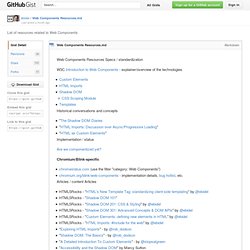
Building WebApps With Yeoman And Polymer. Yo Polymer – A Whirlwind Tour Of Web Component Tooling. Web Components are going to change everything you think you know about building for the web. For the first time, the web will have low level APIs allowing us to not only create our own HTML tags but also encapsulate logic and CSS. No more global stylesheet soup or boilerplate code! It’s a brave new world where everything is an element. In my talk from DotJS, I walk through what Web Components have to offer and how to build them using modern tooling. I’ll show you Yeoman, a workflow of tools to streamline creating web-apps using Polymer, a library of polyfills and sugar for developing apps using Web Components in modern browsers today.
Create custom elements & install elements created by others In this talk you will learn: About the four different specs composing Web Components: Custom Elements, Templates, Shadow DOM and HTML imports. For example, to install Polymer's Web Component polyfills and the library itself, you can run this one liner: and then import it into your application:
Building Web Apps With Yeoman And Polymer: Scaffold your webapps with modern tooling. This article discusses APIs that are not yet fully standardized and still in flux.
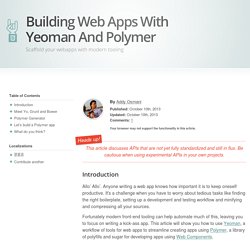
Be cautious when using experimental APIs in your own projects. Introduction Allo’ Allo’. Anyone writing a web app knows how important it is to keep oneself productive. It's a challenge when you have to worry about tedious tasks like finding the right boilerplate, setting up a development and testing workflow and minifying and compressing all your sources. Fortunately modern front-end tooling can help automate much of this, leaving you to focus on writing a kick-ass app. Note: If you're new to Web Components, I recommend reading the fantastic docs about the web platform features they provide.
Meet Yo, Grunt and Bower Yeoman is a man in a hat with three tools for improving your productivity: You can install generators from npm (Node Packaged Modules) and there are over 220 generators now available, many of which have been written by the open-source community. . $ npm install -g yo That's it! A whirlwind tour of Web Components with Polymer. List of resources related to Web Components. The Web’s Declarative, Composable Future. The way that languages in the web platform evolve are in direct response to the pain caused by complexity.
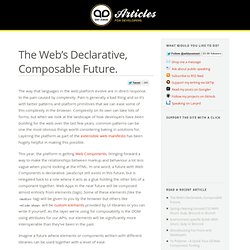
Pain is generally a bad thing and so it’s with better patterns and platform primitives that we can ease some of this complexity in the browser. Complexity on its own can take lots of forms, but when we look at the landscape of how developers have been building for the web over the last few years, common patterns can be one the most obvious things worth considering baking in solutions for. Layering the platform as part of the extensible web manifesto has been hugely helpful in making this possible. This year, the platform is getting Web Components, bringing forward a way to make the relationships between markup and behaviour a lot less vague when you’re looking at the HTML.
Yeoman/generator-polymer.